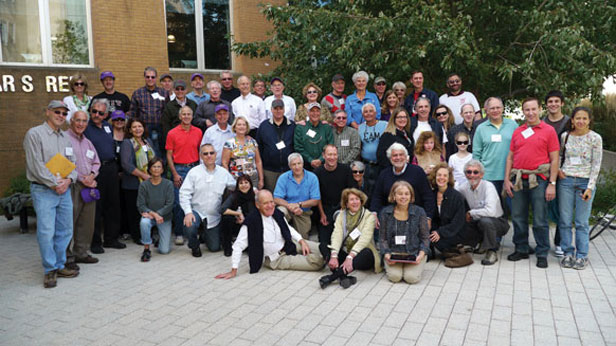
When Breanna Berry ‘12 arrived at the Institute as a freshman in the fall of 2008, one of the first things she did was join Alpha Phi sorority. Then she joined another group, the Program in Leadership and Undergraduate Success. And then five more.
“Student groups give people an opportunity to figure out who they are … and cultivate relationships with people who will encourage them to reach their goals,” Berry says. And with more than 450 to choose from, students are likely to find at least one good match.
Student groups “help in looking at the bigger picture,” says graduate student Prakash Narayan Govindan, president of MIT Bhakti Yoga. “You get to sort of take a step back from all the stress and work and just hang out with friends and do something you like.”
“Groups are an essential part of the MIT experience,” Berry adds.
They’re an essential part of the MIT alumni experience, too: a central focus of the MIT Alumni Association, in fact, is to ensure that clubs, classes, affinity groups, and interest groups remain strong and viable sources of community for graduates. To that end, the Association supports more than 50 alumni networks and affinity groups, such as the 32-year-old Black Alumni of MIT (BAMIT), and 90 Institute clubs worldwide.
Stephen Ho, SM ‘84, president of the MIT Club of Singapore, says that after MIT, alumni clubs help members retain ties to the Institute and encourage lifelong learning. At a recent club event, he says, he learned a lot about space research from Professor Dava Newman, SM ‘89, PhD ‘92, who was involved in the design of space suits for astronauts.
Ho says members of the Club of Singapore are enthusiastic about connecting, not just to area alumni but also to alumni in other clubs. Singapore club members recently partnered with the Club of Malaysia to host joint lunches with speakers from each club. In Singapore, they held a joint golf match with the Club of Chicago and a joint Chinese New Year celebration with the Club of China.
Washington, D.C., resident Jennifer Navarro ‘00 says a fellow graduate encouraged her to get involved with her local club even though she expected to be in the area for only a short time. “However, it’s six years later, I’m still here … and I really enjoy the mentorship by some of our more experienced alums in the club,” she says. “They always offer wonderful career advice and are willing to help in any way they can.” Navarro currently serves as president of the D.C. club.
Affinity groups have also enriched alumni lives. The Association of MIT Alumnae (AMITA) is dedicated to promoting alumnae accomplishments, maintaining connections among female graduates, and supporting women on campus. Carol Hooker ‘67, who lives in Indianapolis, says she became a member “as a means to stay connected to MIT” after she retired. Membership, she notes, has afforded her a closer connection to campus “and given me a wonderful excuse to come visit!”
Cambridge resident Aileen Wu ‘03 agrees. “AMITA and other MIT alumni groups provide valuable opportunities to take on leadership roles and network,” she says. “For example, this past year [several other members] and I set up a series of discussion panels focused on women in entrepreneurship. Just being part of AMITA and the MIT Alumni Association means that we have access to a huge group of people who are interested in attending events—alumni, current students, etc.—as well as many companies who are interested in helping to fund them.”
Many alumni have also found that shared interests—education or energy, for example—can bring a group together and strengthen it. More than 300 people belong to the K–12 STEM Education Volunteer Network, which aims to engage students in science, technology, engineering, and math pursuits. Membership in the Energy, Environment, and Sustainability (EES) network is nearing 1,000. Doug Spreng ‘65, a California resident who worked at Hewlett-Packard and other high-tech companies, has been active with EES since his retirement. He advocates for energy research, and he persuaded class leaders to promote MIT’s new energy minor as a theme for their reunion gifts.
“As is usually the case when working with bright, committed people on a tough project, friendships spring up in the process,” says Spreng. “For me, it’s some of the EES leaders as well as a number of MIT professors, including Tonio Buonassisi, Vladimir Bulovic´, Jeff Grossman, and others, who have given generously of their time to support the EES program.” Like so many other alumni, he’s found that these groups can serve as catalysts for both mentoring relationships and lifelong friendships.
Keep Reading
Most Popular
Large language models can do jaw-dropping things. But nobody knows exactly why.
And that's a problem. Figuring it out is one of the biggest scientific puzzles of our time and a crucial step towards controlling more powerful future models.
The problem with plug-in hybrids? Their drivers.
Plug-in hybrids are often sold as a transition to EVs, but new data from Europe shows we’re still underestimating the emissions they produce.
Google DeepMind’s new generative model makes Super Mario–like games from scratch
Genie learns how to control games by watching hours and hours of video. It could help train next-gen robots too.
How scientists traced a mysterious covid case back to six toilets
When wastewater surveillance turns into a hunt for a single infected individual, the ethics get tricky.
Stay connected
Get the latest updates from
MIT Technology Review
Discover special offers, top stories, upcoming events, and more.